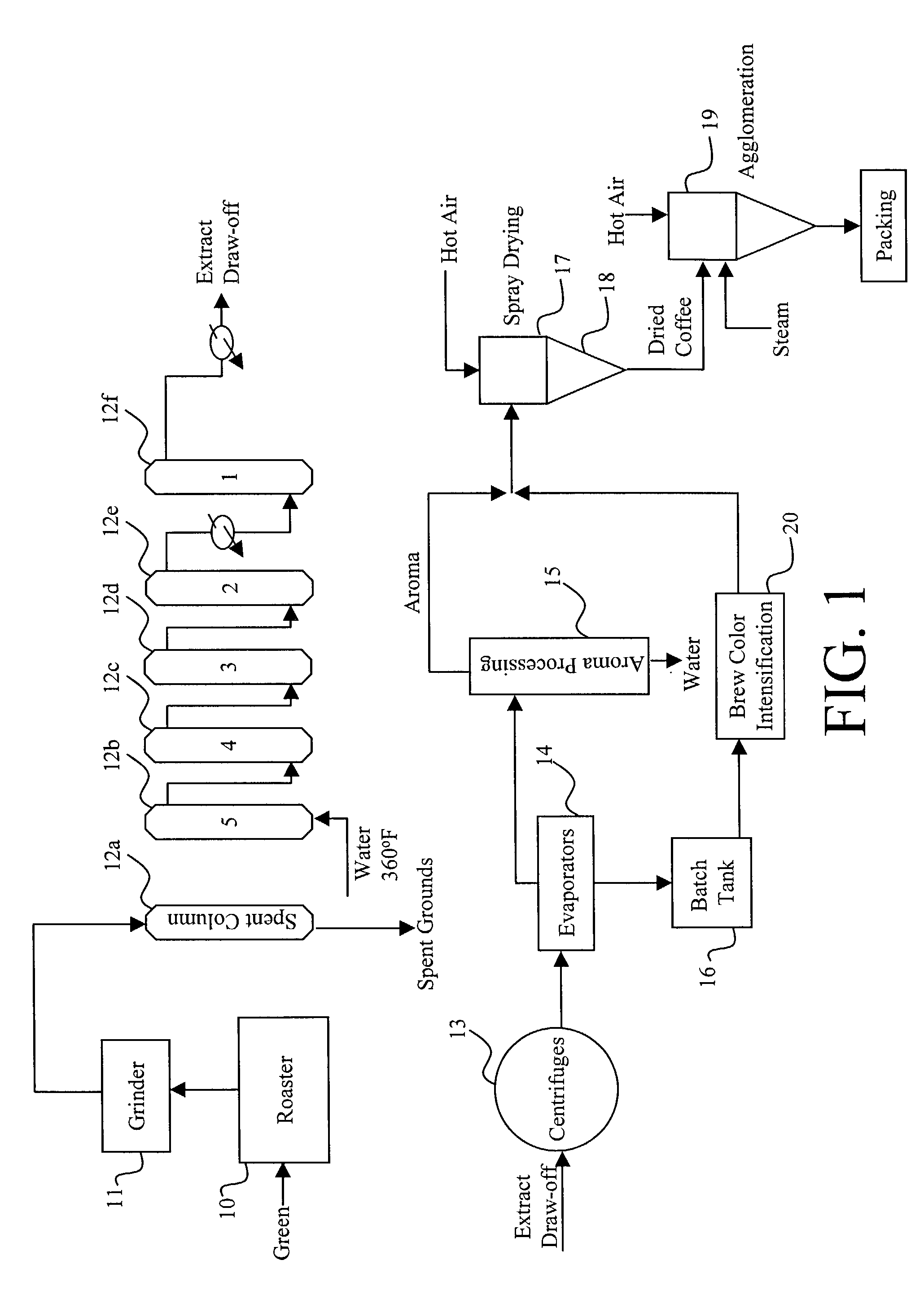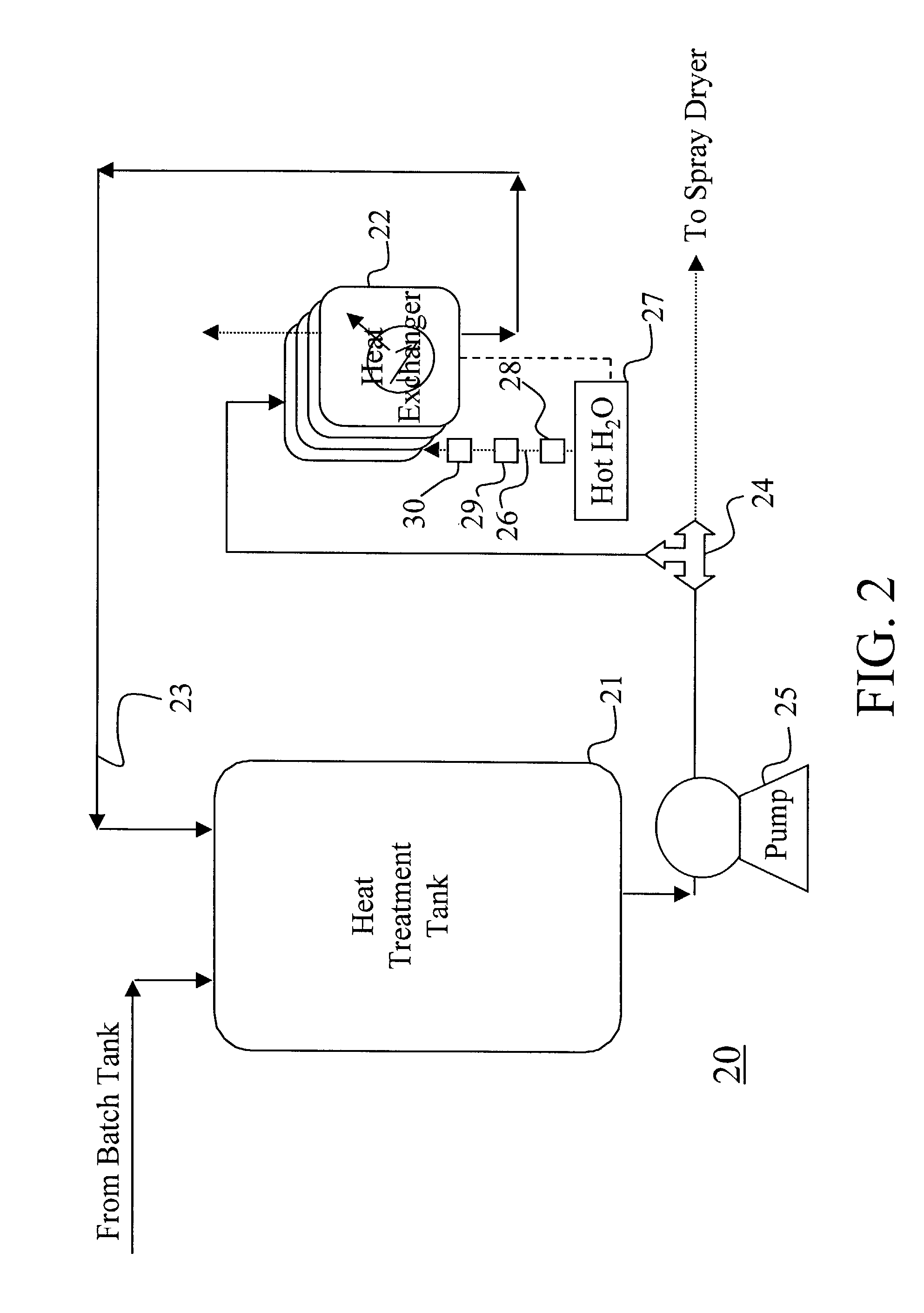Soluble coffee brew color intensification
a technology of soluble coffee and brew color, which is applied in the field of intensifying the brew color of soluble coffee, can solve the problem that the color cannot be changed without affecting the flavor, and achieve the effect of not altering the coffee flavor, but increasing the coffee color
- Summary
- Abstract
- Description
- Claims
- Application Information
AI Technical Summary
Benefits of technology
Problems solved by technology
Method used
Image
Examples
example 1
[0043]Soluble coffee extract produced from roasted coffee with a roast color of 60° L (photovolt) is prepared using known art until immediately prior to spray-drying where upon the coffee extract is heated to 190 to 200° F. and held at that temperature for 10 to 60 minutes at atmospheric pressure. The extract is subsequently spray-dried. When reconstituted to a coffee concentration of 1% coffee solids, the in-cup brew color is noticeably darker than the same coffee that was not intensified thus giving the appearance of a dark rich cup of coffee when in fact the coffee was produced from what is known in the art as a light roast coffee. The flavor of the reconstituted intensified color coffee tastes the same as that of non-intensified color coffee.
[0044]Referring to FIG. 3, the coffee brew color is compared to the brew intensification processing time for Example 1, where the y-axis comprises Macbeth Hunter values of the brew color and the x-axis is the hold-up time (i.e. brew color in...
example 2
[0046]A first batch of soluble coffee extract produced from roasted coffee with a roast color of 40° L (photovolt) was prepared using conventional brewing processes known in the art, until immediately prior to the spray-drying step. Prior to a conventional spray-drying step, the coffee extract was heated to 190 to 200° F. and held at that temperature for 10 to 60 minutes. The extract was subsequently spray-dried.
[0047]A second batch of coffee extract produced from roasted coffee with a roast color of 37° L (photovolt) was prepared using a conventional brewing process including spray-drying. The second batch was not subjected to brew color intensification.
[0048]The two batches were reconstituted to the same coffee solids concentration. The two batches taste different from each other and the in-cup brew color are different. The 37° L batch tastes somewhat burnt and has a very dark brew color relative to the 40° L batch prior to brew color intensification.
[0049]Subsequently, the second...
example 3
[0051]Two soluble coffee extract batches at 52% soluble solids concentration were heated to 175° F. and 195° F. and held for about 60 minutes. Samples at 15 minute intervals, beginning at time 0 samples, were spray-dried to form a dry powder. The spray-dried powder samples were then reconstituted to 1% soluble solids concentration and compared to each other.
[0052]The results of Example 3 are presented in FIG. 5 which illustrates the brew color of the respective soluble coffee extracts produced. As shown in FIG. 5, the sample heated to 195° F. became substantially darker after 15 minutes and then the color intensity leveled off. Beyond 60 minutes, at 195° F., the flavor of the coffee began to change as determined organoleptically by a trained expert coffee panel. The sample heated at 175° F. had very little color change over the same time period. Extracts that were heated to a temperature higher than 195° F., e.g., greater than 200° F. developed off flavor notes probably due to degra...
PUM
 Login to View More
Login to View More Abstract
Description
Claims
Application Information
 Login to View More
Login to View More - R&D
- Intellectual Property
- Life Sciences
- Materials
- Tech Scout
- Unparalleled Data Quality
- Higher Quality Content
- 60% Fewer Hallucinations
Browse by: Latest US Patents, China's latest patents, Technical Efficacy Thesaurus, Application Domain, Technology Topic, Popular Technical Reports.
© 2025 PatSnap. All rights reserved.Legal|Privacy policy|Modern Slavery Act Transparency Statement|Sitemap|About US| Contact US: help@patsnap.com



